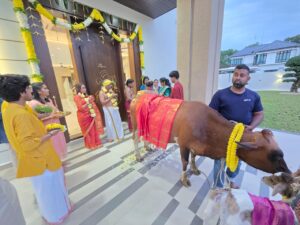

On Friday, I witnessed a deeply symbolic and rarely seen ritual at a housewarming of a new bungalow in Johor.
Amid the chants of Vedic hymns, the fragrance of incense, and the laughter of family members, a cow and its calf were led gently into the newly built home at Country Residence in Masai.
The sight was both humbling and uplifting, a moment that seemed to bridge the ancient with the modern.
The cow, adorned with a shawl and garland of fresh jasmine and turmeric paste smeared on her forehead, walked with calm dignity, as if aware of her sacred role.
The calf followed closely, hesitating for a moment before stepping onto the freshly washed grand floor.
There was an air of reverence as the property owner, R. Nantakumar, his wife, Wijaya Selvi, and guests folded their hands and bowed slightly, not to an animal, but to what it represented: the very essence of life, purity, and sustenance.
In the Vedic tradition, the cow is not just a creature but a divine symbol of abundance.
Its presence during a housewarming is considered an invocation of Mother Earth herself, whose energies the new dwelling must align with before it becomes a true home.
According to scripture, the celestial wish-fulfilling cow embodies prosperity, compassion, and nourishment.
Bringing it into a newly constructed house marks a divine act of inviting the universe’s nurturing forces to take residence.
The calf, in turn, symbolises continuity, protection, and future generations. It is believed that their bond blesses the family with harmony, fertility, and longevity.
As the ceremony unfolded, something remarkable occurred: the cow, upon entering the main threshold, gently lowered its head, mooed softly, and urinated and dropped its dung.
There was no disturbance, no embarrassment; instead, the chief priest, Someshvarn Sivachariar, smiled and said, “Lakshmi (the goddess of wealth and fortune) has entered this home.”
This act, often misunderstood by those unfamiliar with the symbolism, is in fact one of the most auspicious signs in Hindu culture.
According to Vasthu Sastra, a home is a living organism whose energies must be purified and balanced before the family can dwell within it.
Cow urine and dung have long been regarded as natural purifiers, both spiritually and scientifically.
The ancient texts describe them as cleansing agents that neutralise negative vibrations and sanctify the space.
Modern science, interestingly, acknowledges their antibacterial properties and their role in balancing atmospheric microbes.
When a cow naturally releases urine or dung upon entering a property, it is considered a sign that the divine energy has accepted the home, blessing it with purity and prosperity.
The act signifies that the Mother Earth has been appeased and that the dwelling is ready to receive the positive flow of life.
The ritual subtly reminds us that even our most modern creations, marble floors, steel beams, and glass facades, ultimately stand upon the sacred soil of the Earth, which must be honoured.
As I watched the ceremony, I reflected on how rare it is today to see such customs performed with sincerity.
In urban life, where most people live in apartments or gated communities, bringing a live cow and calf indoors may not be feasible.
Yet, the essence of the ritual continues in adapted forms. Many priests now use symbolic substitutes such as sprinkling diluted dung and urine at the entrances and corners of the house, or applying a thin layer of the dung on the threshold before washing it away.
Some families keep a small idol or framed image of a cow and calf in the prayer room to represent the same divine energy.
Others, especially in cities, choose to express this reverence through a generous act, donating fodder, feeding cows, or contributing to a cow shelter on the day of their housewarming.
The gesture is believed to carry equal spiritual merit.
Even in modern Vasthu Sastra practice, the focus is not on ritual for ritual’s sake, but on the energy it invokes.
The cow represents the five elements — earth, water, fire, air, and space — which must exist in harmony within a property.
The sprinkling of a sacred mixture of milk, curd, ghee, dung, and urine during a house warming serves to balance these elements and consecrate the energetic core of the house.
Watching Nanthakumar’s family perform this age-old ceremony with such devotion reminded me of how ancient Indian spiritual wisdom remains relevant to this day.
The event may seem rustic to the uninitiated, but its message is insightful: a home is not truly blessed by paint or polish, but by purity of intent and respect for all forms of life.
As the cow and calf departed, leaving behind faint hoof prints and a trail of holy energy, the house seemed to come alive; no longer a structure of bricks and mortar, but a living, breathing sanctuary.
The priest concluded the ceremony by saying, “Now the Earth has accepted this home; may it shelter generations with peace and prosperity.”
Indeed, in that simple act of welcoming a cow and its calf, I saw a beautiful union of the spiritual and the natural; a reminder that true sanctity begins when we honour life in all its forms, from the smallest grain of soil to the gentle eyes of the revered cow.
Award-winning writer Dr T. Selva is the author of the bestsellers Vasthu Sastra Guide and Secrets of Happy Living. To get a copy, WhatsApp 019-2728464. He can be reached at drtselvas@gmail.com. Facebook: Vasthu Sastra


